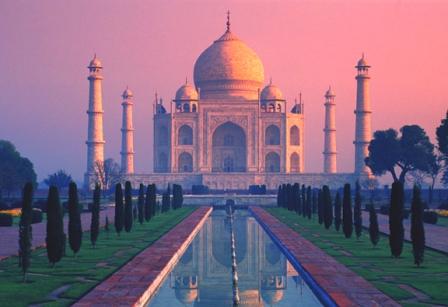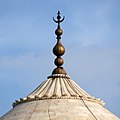The Taj Mahal (pronounced /tɑdʒ mə'hɑl/ ---- Hindi: ताज महल; Persian/Urdu: تاج محل) is a mausoleum located in Agra, India, built by Mughal Emperor Shah Jahan in memory of his favorite wife, Mumtaz Mahal.
The Taj Mahal (also "the Taj") is considered the finest example of Mughal architecture, a style that combines elements from Indian and Islamic architectural styles, especially those of Persia and Turkey. In 1983, the Taj Mahal became a UNESCO World Heritage Site and was cited as "the jewel of Muslim art in India and one of the universally admired masterpieces of the world's heritage."
While the white domed marble mausoleum is its most familiar component, the Taj Mahal is actually an integrated complex of structures. Building began around 1632 and was completed around 1653, and employed thousands of artisans and craftsmen.[1]. Ustad Ahmad Lahauri is generally considered to be the principal designer of the Taj Mahal.[2]
Origin and inspiration
In 1631, Shah Jahan, emperor during the Mughal empire's period of greatest prosperity, was griefstricken when his third wife, Mumtaz Mahal, died during the birth of their fourteenth child, Gauhara Begum.[3] The court chronicles of Shah Jahan's grief illustrates the love story traditionally held as an inspiration for Taj Mahal.[4] [5] The construction of Taj Mahal begun soon after Mumtaz's death with the principal mausoleum completed in 1648. The surrounding buildings and garden were finished five years later. Emperor Shah Jahan himself described the Taj in these words:[6]
Should guilty seek asylum here,
Like one pardoned, he becomes free from sin.
Should a sinner make his way to this mansion,
All his past sins are to be washed away.
The sight of this mansion creates sorrowing sighs;
And the sun and the moon shed tears from their eyes.
In this world this edifice has been made;
To display thereby the creator's glory.
The Taj Mahal incorporates and expands on design traditions of Persian and earlier Mughal architecture. Specific inspiration came from successful Timurid and Mughal buildings including the Gur-e Amir (the tomb of Timur, progenitor of the Mughal dynasty, in Samarkand),[7] Humayun's Tomb, Itmad-Ud-Daulah's Tomb (sometimes called the Baby Taj), and Shah Jahan's own Jama Masjid in Delhi. While earlier Mughal buildings were primarily constructed of red sandstone, Shah Jahan promoted the use of white marble inlaid with semi-precious stones, and buildings under his patronage reached new levels of refinement.[8]
Architecture
The tomb
The focus of the Taj Mahal is the white marble tomb, which stands on a square plinth consisting of a symmetrical building with an iwan, an arch-shaped doorway, topped by a large dome. Like most Mughal tombs, basic elements are Persian in origin.
The base structure is a large, multi-chambered structure. The base is essentially a cube with chamfered edges and is roughly 55 meters on each side (see floor plan, right). On the long sides, a massive pishtaq, or vaulted archway, frames the iwan with a similar arch-shaped balcony.
On either side of the main arch, additional pishtaqs are stacked above and below. This motif of stacked pishtaqs is replicated on chamfered corner areas as well. The design is completely symmetrical on all sides of the building. Four minarets, one at each corner of the plinth, facing the chamfered corners, frame the tomb. The main chamber houses the false sarcophagi of Mumtaz Mahal and Shah Jahan; their actual graves are at a lower level.
The marble dome that surmounts the tomb is its most spectacular feature. Its height is about the same size as the base of the building, about 35 meters, and is accentuated as it sits on a cylindrical "drum" of about 7 metres high. Because of its shape, the dome is often called an onion dome (also called an amrud or guava dome). The top is decorated with a lotus design, which serves to accentuate its height as well. The shape of the dome is emphasised by four smaller domed chattris (kiosks) placed at its corners. The chattri domes replicate the onion shape of the main dome. Their columned bases open through the roof of the tomb and provide light to the interior. Tall decorative spires (guldastas) extend from edges of base walls, and provide visual emphasis to the height of the dome. The lotus motif is repeated on both the chattris and guldastas. The dome and chattris are topped by a gilded finial, which mixes traditional Persian and Hindu decorative elements.
The main dome is crowned by a gilded spire or finial. The finial, made of gold until the early 1800s, is now made of bronze. The finial provides a clear example of integration of traditional Persian and Hindu decorative elements. The finial is topped by a moon, a typical Islamic motif, whose horns point heavenward. Because of its placement on the main spire, the horns of moon and finial point combine to create a trident shape, reminiscent of traditional Hindu symbols of Shiva.[9]
At the corners of the plinth stand minarets, the four large towers each more than 40 meters tall. The minarets display the Taj Mahal's penchant for symmetry. These towers are designed as working minarets, a traditional element of mosques as a place for a muezzin to call the Islamic faithful to prayer. Each minaret is effectively divided into three equal parts by two working balconies that ring the tower. At the top of the tower is a final balcony surmounted by a chattri that mirrors the design of those on the tomb. The minaret chattris share the same finishing touches, a lotus design topped by a gilded finial. Each of the minarets were constructed slightly outside of the plinth, so that in the event of collapse, a typical occurrence with many such tall constructions of the period, the material from the towers would tend to fall away from the tomb.
| Main iwan and side pishtaqs |
Exterior decoration
The exterior decorations of the Taj Mahal are among the finest to be found in Mughal architecture. As the surface area changes, a large pishtaq has more area than a smaller one, and the decorations are refined proportionally. The decorative elements were created by applying paint or stucco, or by stone inlays or carvings. In line with the Islamic prohibition against the use of anthropomorphic forms, the decorative elements can be grouped into either calligraphy, abstract forms or vegetative motifs.
The calligraphy found in Taj Mahal are of florid thuluth script, created by Persian calligrapher Amanat Khan, who signed several of the panels. The calligraphy is made by jasper inlaid in white marble panels, and the work found on the marble cenotaphs in the tomb is extremely detailed and delicate. Higher panels are written slightly larger to reduce the skewing effect when viewing from below. Throughout the complex, passages from the Qur'an are used as decorative elements. Recent scholarship suggests that Amanat Khan chose the passages as well.[10][11] The texts refer to themes of judgment and include:
Surah 91 - The Sun
Surah 112 - The Purity of Faith
Surah 89 - Daybreak
Surah 93 - Morning Light
Surah 95 - The Fig
Surah 94 - The Solace
Surah 36 - Ya Sin
Surah 81 - The Folding Up
Surah 82 - The Cleaving Asunder
Surah 84 - The Rending Asunder
Surah 98 - The Evidence
Surah 67 - Dominion
Surah 48 - Victory
Surah 77 - Those Sent Forth
Surah 39 - The Crowds
As one enters through Taj Mahal Gate, the calligraphy reads "O Soul, thou art at rest. Return to the Lord at peace with Him, and He at peace with you."[12][11]
patterns.
Vegetative motifs are found at the lower walls of the tomb. They are white marble dados that have been sculpted with realistic bas relief depictions of flowers and vines. The marble has been polished to emphasise the exquisite detailing of these carvings. The dado frames and archway spandrels have been decorated with pietra dura inlays of highly stylised, almost geometric vines, flowers and fruits. The inlay stones are yellow marble, jasper and jade, leveled and polished to the surface of the walls.
Interior decoration
The interior chamber of the Taj Mahal steps far beyond traditional decorative elements. Here the inlay work is not pietra dura, but lapidary of precious and semiprecious gemstones. The inner chamber is an octagon with the design allowing for entry from each face, though only the south garden-facing door is used. The interior walls are about 25 metres high and topped by a "false" interior dome decorated with a sun motif. Eight pishtaq arches define the space at ground level. As with the exterior, each lower pishtaq is crowned by a second pishtaq about midway up the wall. The four central upper arches form balconies or viewing areas and each balcony's exterior window has an intricate screen or jali cut from marble. In addition to the light from the balcony screens, light enters through roof openings covered by chattris at the corners. Each chamber wall has been highly decorated with dado bas relief, intricate lapidary inlay and refined calligraphy panels, reflecting in miniature detail the design elements seen throughout the exterior of the complex. The octagonal marble screen or jali which borders the cenotaphs is made from eight marble panels. Each panel has been carved through with intricate pierce work. The remaining surfaces have been inlaid with semiprecious stones in extremely delicate detail, forming twining vines, fruits and flowers.
Muslim tradition forbids elaborate decoration of graves and hence Mumtaz and Shah Jahan are laid in a relatively plain crypt beneath the inner chamber with their faces turned right and towards Mecca. Mumtaz Mahal's cenotaph is placed at the precise center of the inner chamber with a rectangular marble base of 1.5 meters by 2.5 meters. Both the base and casket are elaborately inlaid with precious and semiprecious gems. Calligraphic inscriptions on the casket identify and praise Mumtaz. On the lid of the casket is a raised rectangular lozenge meant to suggest a writing tablet. Shah Jahan's cenotaph is beside Mumtaz's to the western side. It is the only visible asymmetric element in the entire complex. His cenotaph is bigger than his wife's, but reflects the same elements: a larger casket on slightly taller base, again decorated with astonishing precision with lapidary and calligraphy that identifies Shah Jahan. On the lid of this casket is a traditional sculpture of a small pen box. The pen box and writing tablet were traditional Mughal funerary icons decorating men's and women's caskets respectively. Ninety Nine Names of God are to be found as calligraphic inscriptions on the sides of the actual tomb of Mumtaz Mahal, in the crypt including "O Noble, O Magnificent, O Majestic, O Unique, O Eternal, O Glorious... ". The tomb of Shah Jahan bears a calligraphic inscription that reads; "He traveled from this world to the banquet-hall of Eternity on the night of the twenty-sixth of the month of Rajab, in the year 1076 Hijri."
The garden
The complex is set around a large 300-meter square charbagh, a Mughal garden. The garden uses raised pathways that divide each of the four quarters of the garden into 16 sunken parterres or flowerbeds. A raised marble water tank at the center of the garden, halfway between the tomb and gateway, with a reflecting pool on North-South axis reflects the image of the Taj Mahal. Elsewhere, the garden is laid out with avenues of trees and fountains.[13] The raised marble water tank is called al Hawd al-Kawthar, in reference to "Tank of Abundance" promised to Muhammad.[14] The charbagh garden, a design inspired by Persian gardens, was introduced to India by the first Mughal emperor Babur. It symbolizes four flowing rivers of Paradise and reflects the gardens of Paradise derived from the Persian paridaeza, meaning 'walled garden'. In mystic Islamic texts of Mughal period, paradise is described as an ideal garden of abundance with four rivers flowing from a central spring or mountain, separating the garden into north, west, south and east.
Most Mughal charbaghs are rectangular with a tomb or pavilion in the center. The Taj Mahal garden is unusual in that the main element, the tomb, instead is located at the end of the garden. With the discovery of Mahtab Bagh or "Moonlight Garden" on the other side of the Yamuna, Archaeological Survey of India interprets that the Yamuna itself was incorporated into the garden's design and was meant to be seen as one of the rivers of Paradise.[15] The similarity in layout of the garden and its architectural features such as fountains, brick and marble walkways, and geometric brick-lined flowerbeds with Shalimar's suggest that the garden may have been designed by the same engineer, Ali Mardan.[16] Early accounts of the garden describe its profusion of vegetation, including roses, daffodils, and fruit trees in abundance.[17] As the Mughal Empire declined, the tending of the garden declined as well. When the British took over the management of Taj Mahal, they changed the landscaping to resemble that of lawns of London.[18]
Outlying buildings
The Taj Mahal complex is bounded by crenellated red sandstone walls on three sides with river-facing side open. Outside these walls are several additional mausoleums, including those of Shah Jahan's other wives, and a larger tomb for Mumtaz's favorite servant. These structures, composed primarily of red sandstone, are typical of the smaller Mughal tombs of the era. The garden-facing inner sides of the wall are fronted by columned arcades, a feature typical of Hindu temples later incorporated into Mughal mosques. The wall is interspersed with domed kiosks (chattris), and small buildings that may have been viewing areas or watch towers like the Music House, which is now used as a museum.
The main gateway (darwaza) is a monumental structure built primarily of marble and is reminiscent of Mughal architecture of earlier emperors. Its archways mirror the shape of tomb's archways, and its pishtaq arches incorporate calligraphy that decorates the tomb. It utilizes bas-relief and pietra dura (inlaid) decorations with floral motifs. The vaulted ceilings and walls have elaborate geometric designs, like those found in the other sandstone buildings of the complex.
At the far end of the complex, there are two grand red sandstone buildings that are open to the sides of the tomb. Their backs parallel western and eastern walls, and these two buildings are precise mirror images of each other. The western building is a mosque and its opposite is the jawab (answer) whose primary purpose was architectural balance and may have been used as a guesthouse. The distinctions between these two buildings include the lack of mihrab, a niche in a mosque's wall facing Mecca, in the jawab and that the floors of jawab have a geometric design, while the mosque floor was laid with outlines of 569 prayer rugs in black marble. The mosque's basic design is similar to others built by Shah Jahan, particularly to his Masjid-Jahan Numa, or Jama Masjid of Delhi, a long hall surmounted by three domes. The Mughal mosques of this period divide the sanctuary hall into three areas with a main sanctuary and slightly smaller sanctuaries on either side. At the Taj Mahal, each sanctuary opens onto an enormous vaulting dome. These outlying buildings were completed in 1643.
Source: Wikipedia















No comments:
Post a Comment